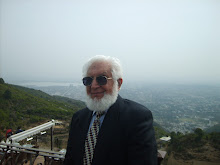Comment on my last note made me think a bit more about investigations some of which are unpleasant, others even painful etc. We, as physicians do not see what the patient is going thru as we feel it is a justifiable procedure. I am not going to relate stories of how some procedures or investigations have caused damage or such unwanted results, because there are some others in which 'good' does result (Like you are doing Ultrasound of the belly for something and you discover a relatively non-symptomatizing lesion of great significance)
I will give my personal impressions as follows. (Iss kay parrnay say buhton ka bhala hoga.)
First--Medicare experience. Retired and depend upon medicare as well as other insurance to cover medical expenses (and now realize what a difference it is when paying for ordinary tests)
Anyway, I personally always saw medicare patients whatever they could pay because it was against my philosophy to reject them. After all somebody has to help those eldrly people. Now that I myself am in that category, I find 'rejection' by a physician (that "our doctor does not see medicare patients; Medicare has very restricted payment schedule.) very painful and I wonder that this physician is going to do when one day he himself will be in that category; what will he do then?
Yes I may have suffered some monetary losses but I was paid by others well. That is not what I am writing however, my purpose is to make you understand how I felt at the time of rejection. felt 'degraded' and small.
Second, when an investigative procedure is performed on me I feel the discomfort and then I rememeber what I did when I was performing, say for example a cerebral angiogram or the most dreaded pneumo-encephalogram (Fortunately it is not done any more since the advent of CT scanning.)
Thirdly, the injections, whenever I needed, or blood drawing or other needle pricking procedures, again I feel (I am pretty stoic and these procedures dont really bother me much but I do feel, to be truthful).
I did have some procedures when I was younger and working myself (Nurses would know me and would be more polite with me then) but now these things do matter.
This therefore is not necessarily a pleasant experience
I will give my personal impressions as follows. (Iss kay parrnay say buhton ka bhala hoga.)
First--Medicare experience. Retired and depend upon medicare as well as other insurance to cover medical expenses (and now realize what a difference it is when paying for ordinary tests)
Anyway, I personally always saw medicare patients whatever they could pay because it was against my philosophy to reject them. After all somebody has to help those eldrly people. Now that I myself am in that category, I find 'rejection' by a physician (that "our doctor does not see medicare patients; Medicare has very restricted payment schedule.) very painful and I wonder that this physician is going to do when one day he himself will be in that category; what will he do then?
Yes I may have suffered some monetary losses but I was paid by others well. That is not what I am writing however, my purpose is to make you understand how I felt at the time of rejection. felt 'degraded' and small.
Second, when an investigative procedure is performed on me I feel the discomfort and then I rememeber what I did when I was performing, say for example a cerebral angiogram or the most dreaded pneumo-encephalogram (Fortunately it is not done any more since the advent of CT scanning.)
Thirdly, the injections, whenever I needed, or blood drawing or other needle pricking procedures, again I feel (I am pretty stoic and these procedures dont really bother me much but I do feel, to be truthful).
I did have some procedures when I was younger and working myself (Nurses would know me and would be more polite with me then) but now these things do matter.
This therefore is not necessarily a pleasant experience
